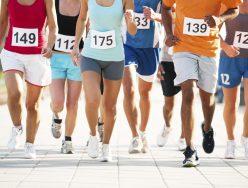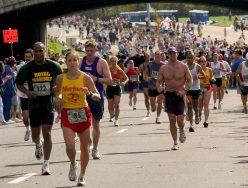If you are soon running (or have just run) a Fall marathon, you have trained hard and tapered carefully for the race. In order to stay healthy and injury-free, it is equally important for you to follow a good plan for recovery on race day and in the days and weeks following your race:
Marathon Day Post-Race Activities:
- Get your Finisher Photo Taken! You will want the finished photo as a keepsake later so take the time to wait in line and get this photo taken, even if you feel like you are just too tired.
- Keep moving immediately after the race. Keep walking slowly and/or keep standing and moving, even in line for the race photo! You definitely don’t want to sit down and run the risk of cramping or tightening up to the point where you can’t stand up or walk.

Hydration/Fueling –
- Immediately after the race (within 30-60 minutes), you should replenish with fluids and a small protein & carb snack once you feel that your stomach can handle it. This will give your body the tools it needs to start repairing the tissue you damaged during the race.
- Continue with frequent, small carb + protein mini-meals and with good hydration throughout the remainder of race day
- You may want to consider running cold water over your legs and hips or standing in a cool swimming pool later in the day. This will help to limit the larger amount of inflammation your body produces after a difficult marathon race. [Note that you only want to do this after your marathon race, not after every long run. Recent studies have shown that cool water treatment can interfere with the rebuilding (inflammation and recovery) that your body undergoes in response to long run training. So after long runs you should let your body recover naturally from the run to make you stronger for the next, more difficult long run.]
- Consider some very light foam rolling if you are experiencing significant tightness in certain areas, but definitely don’t be too aggressive with it. Your muscles and other tissues are susceptible to injury right after the race.
- Wearing compression clothing later in a day may help reduce inflammation and help with recovery. Compression socks (knee-high or higher) or tights are especially useful if you have to fly home from a destination race either on race day or the day after.
- Do some very light stretching later in a day – be gentle.
- Consider some very light activity later in the day such as walking the dog or a casual stroll in your neighborhood. This will help keep your muscles loose.
- Celebrate your success!! Enjoy your healthy post-race meal and savor your accomplishment with friends and family! Very few people complete a marathon and you are one of a select group!
- Try not to do anything stressful during the remainder of race day. If you are on a destination marathon trip, save the sightseeing for the next few days and don’t try to sightsee on race day.
- Get a good night’s sleep. You probably slept poorly the night before the race, so try to get a full night’s sleep the night after the race.
1-3 days post-race:
- Try 10-15 minutes of walking or jogging or another light exercise as long as you aren’t feeling injured. If you feel any pain or unusual discomfort, stop right away.
- You may want to schedule a very light massage two to three days after the race. Make sure your massage therapist knows you are two to three days post-marathon and make sure the therapist is experienced in working with post-marathon clients.
- Continue to wear compression clothing if it makes you feel better and definitely wear compression socks (knee-high or higher) or tights if you are flying during this timeframe.
- Post your photos & commentary on social media. Continue to celebrate and share your accomplishments with your friends and family – you earned it!
- Avoid NSAIDs or other pain medication if possible – it may mask any injuries you might have and may interfere with your bodies’ natural healing process.
3-7 days post-race:
- Continue with Light activity – walking and/or short bouts of easy jogging.
- Follow the ‘one mile per day’ rule: on any given day, don’t run more miles than days after the marathon. For example, 1 week after the marathon, do not exceed 7 miles running on that day.
- Expect more deep fatigue than earlier in the week. The adrenaline rush of finishing the marathon may be wearing off now, so don’t be surprised if your soreness and/or fatigue increases during this period.
- Expect Post Marathon Syndrome (see Post Marathon Syndrome section below)
1-4 weeks post-race:
- Ease back into your training very slowly – this will be similar to your taper, except in reverse:
- Complete rest or very easy work the first week
- Continue to follow the ‘one mile per day’ rule discussed above
- 25-50% of normal mileage in week 2
- 50-70% of normal mileage in week 3
- 60-80% of normal mileage in week 4
- It will take 30 days for you to achieve a full recovery
- Eat a healthy diet! Your body needs high-quality fuel for the repair and repair of tissue.
- Hydrate! Your body also needs adequate hydration to flush inflammation from the body and for the repair and rebuilding of tissue.
The Mental Game – Prepare for Post-Marathon Syndrome
You may be surprised at how you feel mentally after your marathon, especially if it was your first marathon and/or you achieved a Personal Record or Boston Qualifying time. Instead of feeling excited about your accomplishment, you may feel depressed or anxious, or you may feel like you don’t have any motivation. This is common and stems from your depleted physical state in combination with the fact that you have lost one of the major goals and sources of structure in your life (your marathon training plan). Here are some tips on how to break out of Post-Marathon Syndrome:
- Analyze your race result and process – this will help you determine what you need to do differently (and/or the same) in your next race
- Set another goal (not necessarily a marathon or running goal) – you need to restore the structure in your life that you have lost now that your marathon training is over. You may not want to do another marathon as your next major goal, but set some kind of new goal. Perhaps a shorter race or an accomplishment in another sport or hobby.
- View rest as part of your training plan. Remind yourself that during this month of recovery, you are following a plan – a recovery plan. This plan is every bit as important as your ramp up of your long runs. It is critical to follow the recovery plan to avoid injury and allow your body to recover from the stresses of the marathon race.
- Ease into some cross training. Be gentle, but starting into a new and different physical activity will help break up boredom and will spark your interest in something new. Physically, this will also help to prevent any overuse injuries that might arise from more running.
- Continue to eat a healthy diet and to adequately hydrate to aid your physical recovery as well as your mental recovery. In addition, you don’t want the unwanted weight to creep onto your body during this recovery time and your reduced training volume could allow this to happen if you don’t keep a healthy diet.
- Appreciate your accomplishment! This is key – take some time every day to think about what you have accomplished and how special it is. You worked hard to complete your marathon and you deserve to feel great about it!
Was this Article Helpful?
If this article was helpful to you, please consider linking this article to your own blog or sharing this through the social buttons below. You will also find other great articles at “Exercises“.
- 3shares
- 3Facebook
- 0Twitter
- 0Pinterest
- 0LinkedIn
Laurie Lasseter
Laurie has used her methods to help her clients achieve injury-free race completions (including numerous age group and overall medals) as well as first marathon completions and time goal achievement at all distances (including Boston Marathon-Qualifying efforts).
Laurie owns L2 Performance Training and also trains clients at Edward-Elmhurst Health and Fitness in Woodridge, IL as well as at Charter Fitness (Willowbrook, IL) and LA Fitness (Bolingbrook, IL and Naperville, IL).She also writes regularly for the Naperville Marathon Blog and the Edward-Elmhurst Healthy Driven Life Blog.
For more information visit www.L2PerformanceTraining.com
Latest posts by Laurie Lasseter
- 5-Week Strategy: Transitioning Into Spring Running - May 21, 2017
- Post-Marathon Recovery and Survival - November 16, 2016
- Practicing for Marathon Race Day - September 13, 2016

















